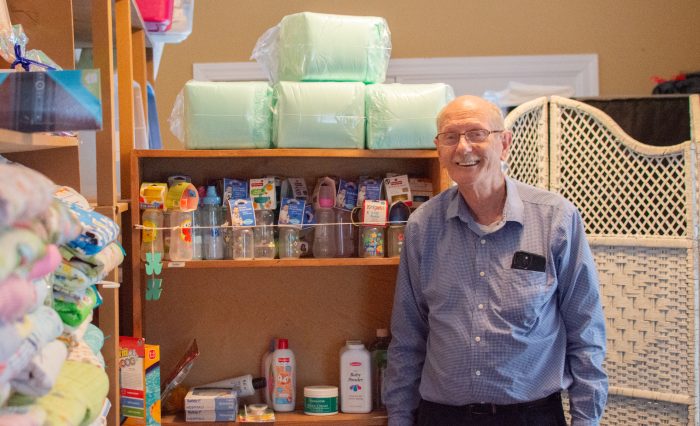Commission hears proposal for stormwater utility program
Published 6:00 am Friday, March 21, 2025

1/10
Swipe or click to see more
City Environmental Manager Matt Powell points out areas of damage caused by heavy rainstorms, as well as the different eras of construction and contractors’ pipework that runs through the drains, on a portion of the underground Whiskey Run stormwater system below the Warren County Justice Center and surrounding area on Tuesday, March 18, 2025. Powell presented to the city commissioners Tuesday evening a way for the city to be more reactive in its stormwater mitigation by implementing a fee structure and a stormwater utility that would generate funds for future needs.
GRACE MCDOWELL / DAILY NEWS
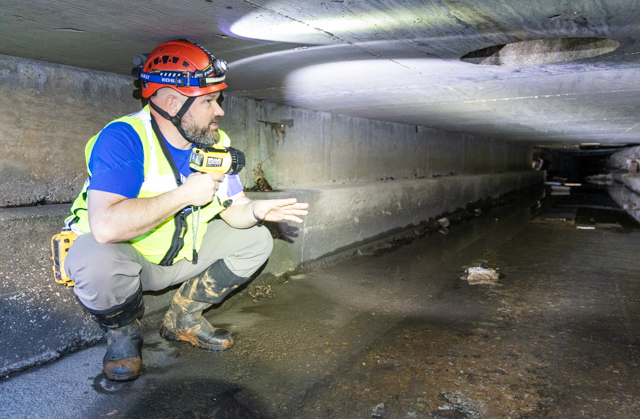
2/10
Swipe or click to see more
City Environmental Manager Matt Powell points out areas of damage caused by heavy rainstorms, as well as the different eras of construction and contractors’ pipework that runs through the drains, on a portion of the underground Whiskey Run stormwater system below the Warren County Justice Center and surrounding area on Tuesday, March 18, 2025. Powell presented to the city commissioners Tuesday evening a way for the city to be more reactive in its stormwater mitigation by implementing a fee structure and a stormwater utility that would generate funds for future needs.
GRACE MCDOWELL / DAILY NEWS
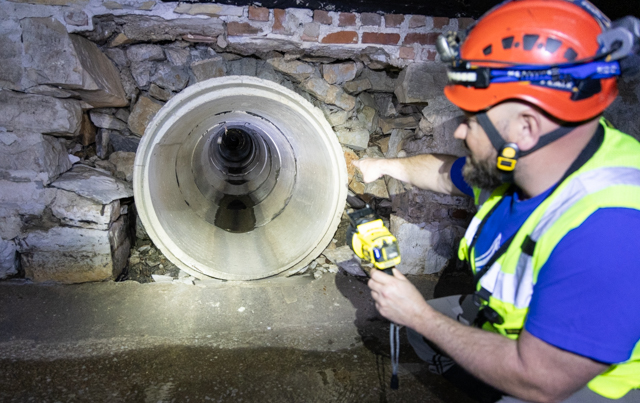
3/10
Swipe or click to see more
City Environmental Manager Matt Powell points out crumbling bedrock and spots where water has pooled creating potential future sinkholes in a spot where contractors installed cement pipes, as well as other areas of damage caused by heavy rainstorms, the different eras of construction and contractors’ pipework that runs through the drains, on a portion of the underground Whiskey Run stormwater system below the Warren County Justice Center and surrounding area on Tuesday, March 18, 2025. Powell presented to the city commissioners Tuesday evening a way for the city to be more reactive in its stormwater mitigation by implementing a fee structure and a stormwater utility that would generate funds for future needs.
GRACE MCDOWELL / DAILY NEWS
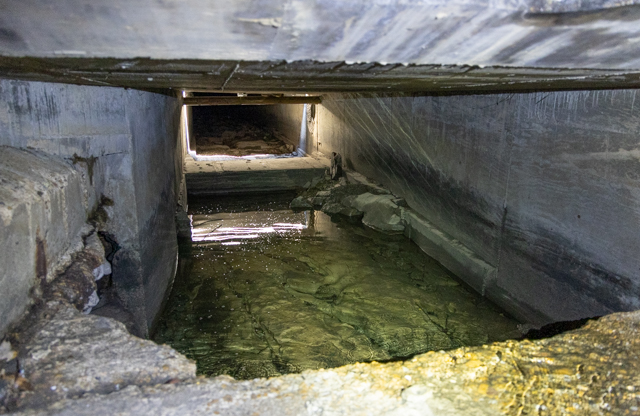
4/10
Swipe or click to see more
City Environmental Manager Matt Powell points out areas of damage caused by heavy rainstorms, as well as the different eras of construction and contractors’ pipework that runs through the drains, on a portion of the underground Whiskey Run stormwater system below the Warren County Justice Center and surrounding area on Tuesday, March 18, 2025. Powell presented to the city commissioners Tuesday evening a way for the city to be more reactive in its stormwater mitigation by implementing a fee structure and a stormwater utility that would generate funds for future needs.
GRACE MCDOWELL / DAILY NEWS

5/10
Swipe or click to see more
Water spills over a drop down in a portion of the underground Whiskey Run stormwater system below the Warren County Justice Center and surrounding area, resulting in eroding bedrock and cement, as City Environmental Manager Matt Powell points out areas of damage caused by heavy rainstorms within the stormwater drains, as well as the different eras of construction and contractors’ pipework that runs through the drains, on Tuesday, March 18, 2025. Powell presented to the city commissioners Tuesday evening a way for the city to be more reactive in its stormwater mitigation by implementing a fee structure and a stormwater utility that would generate funds for future needs.
GRACE MCDOWELL / DAILY NEWS
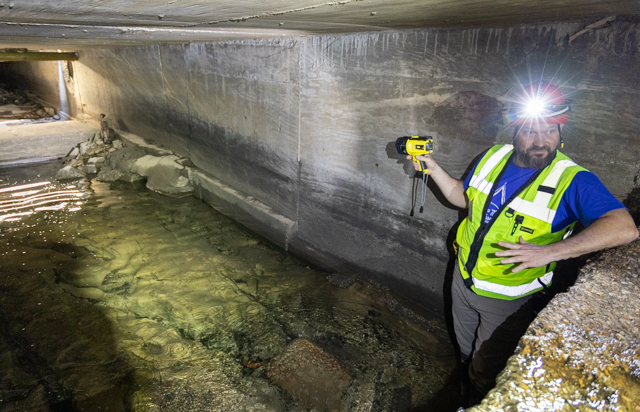
6/10
Swipe or click to see more
City Environmental Manager Matt Powell points out areas of damage caused by heavy rainstorms, as well as the different eras of construction and contractors’ pipework that runs through the drains, on a portion of the underground Whiskey Run stormwater system below the Warren County Justice Center and surrounding area on Tuesday, March 18, 2025. Powell presented to the city commissioners Tuesday evening a way for the city to be more reactive in its stormwater mitigation by implementing a fee structure and a stormwater utility that would generate funds for future needs.
GRACE MCDOWELL / DAILY NEWS
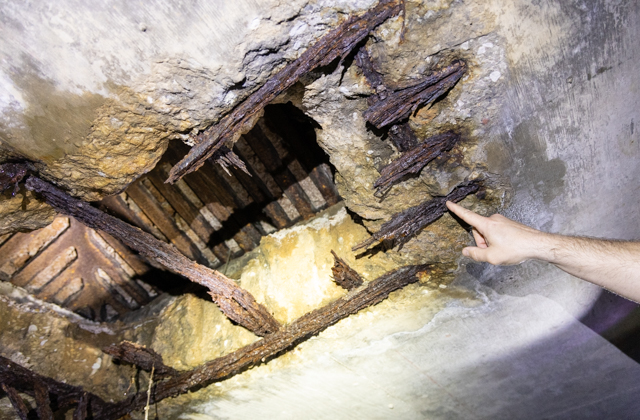
7/10
Swipe or click to see more
City Environmental Manager Matt Powell points out rusted out iron bars and eroding cement in a spot beneath the Warren County Justice Center and other areas of damage caused by heavy rainstorms, as well as the different eras of construction and contractors’ pipework that runs through the drains, on a portion of the underground Whiskey Run stormwater system through parts of downtown Bowling Green on Tuesday, March 18, 2025. Powell presented to the city commissioners Tuesday evening a way for the city to be more reactive in its stormwater mitigation by implementing a fee structure and a stormwater utility that would generate funds for future needs.
GRACE MCDOWELL / DAILY NEWS
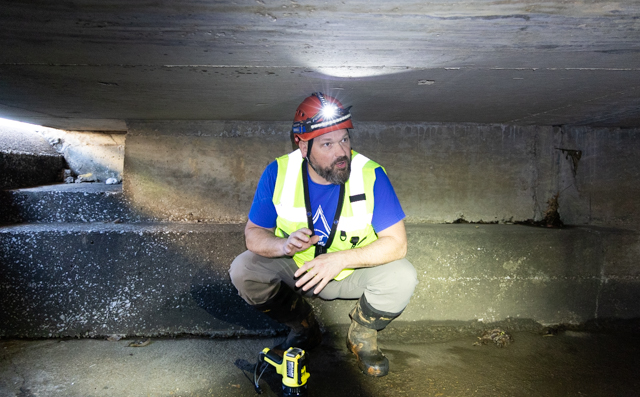
8/10
Swipe or click to see more
City Environmental Manager Matt Powell points out areas of damage caused by heavy rainstorms, as well as the different eras of construction and contractors’ pipework that runs through the drains, on a portion of the underground Whiskey Run stormwater system below the Warren County Justice Center and surrounding area on Tuesday, March 18, 2025. Powell presented to the city commissioners Tuesday evening a way for the city to be more reactive in its stormwater mitigation by implementing a fee structure and a stormwater utility that would generate funds for future needs.
GRACE MCDOWELL / DAILY NEWS

9/10
Swipe or click to see more
City Environmental Manager Matt Powell climbs through a manhole to point out areas of damage caused by heavy rainstorms, as well as the different eras of construction and contractors’ pipework that runs through the drains, on a portion of the underground Whiskey Run stormwater system below the Warren County Justice Center and surrounding area on Tuesday, March 18, 2025. Powell presented to the city commissioners Tuesday evening a way for the city to be more reactive in its stormwater mitigation by implementing a fee structure and a stormwater utility that would generate funds for future needs.
GRACE MCDOWELL / DAILY NEWS
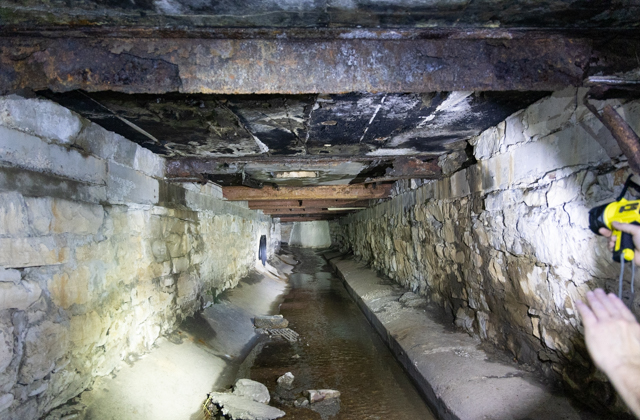
10/10
Swipe or click to see more
City Environmental Manager Matt Powell points out rusted out metal beams and other areas of damage caused by heavy rainstorms, as well as the different eras of construction and contractors’ pipework that runs through the drains, on a portion of the underground Whiskey Run stormwater system below the Warren County Justice Center and surrounding area on Tuesday, March 18, 2025. Powell presented to the city commissioners Tuesday evening a way for the city to be more reactive in its stormwater mitigation by implementing a fee structure and a stormwater utility that would generate funds for future needs.
GRACE MCDOWELL / DAILY NEWS
Bowling Green’s stormwater mitigation system spans more than 200 miles underground, and it’s in need of repair.
To get ahead of possible issues with the system, some have proposed creating a stormwater utility and fee structure that would collect money to cover costs associated with working on the system.
“What we’re proposing is a programmatic approach,” City Environmental Manager Matt Powell told the Daily News. “We’re going to continually be assessing the system for … where do we need new infrastructure, where do we need replacement infrastructure, where do we need rehabilitated infrastructure.”
The idea of a separate stormwater utility was floated to city officials in January during the city’s annual strategic planning session. No action was taken then. On Tuesday, Powell delivered a presentation to commissioners that detailed how funds would be collected and used for stormwater projects. No official action was taken by commissioners on Tuesday.
A Fee In Lieu of Construction, or FILOC, was proposed. Powell told commissioners that the FILOC would be a one-time fee applied to projects that take up more than one acre of land and measure at least 10,000 square feet.
Powell said FILOCs will be paid into by developers, generating a “pool” of money. This money would be used by the city to fund an expansion of “water quality protection measures” across town.
“This is a program that’s highly favored by developers because it cheapens the cost of their development,” Powell said, adding that by paying a FILOC developers would still have to make sure stormwater runoff goes where it is supposed to.
For a development on a 25% impervious surface — that is, surface that does not allow rainwater to soak into the ground — the fee would run $571.73 per acre. For a development with 75% impervious surface, the fee would total $1,715.19 per acre. The fee for commercial projects, Powell said, would total $10,500 per acre.
By itself, Powell said, the FILOC would not generate enough revenue to cover needs in perpetuity. Powell proposed a stormwater utility to supplement the FILOC, which would collect revenue from residential and commercial properties that would fund stormwater management.
Warren County already has a stormwater utility in place. City residential properties would be charged $4 per month on their water bills, the same as the county’s rate. For commercial properties, the monthly rate would be $4 per “equivalent residence unit.”
An average ERU measures around 3,100 square feet. Powell said a 20,000 square foot commercial development would take up 6.5 ERUs, meaning their monthly bill would total to $25.81. Bowling Green would be the 15th municipality in Kentucky to implement this process.
While the FILOC and the stormwater utility would have to both be approved by the commission at the same time, some commissioners questioned whether another funding route could be found to supplement the FILOC.
Commissioner Melinda Hill and Bowling Green Mayor Todd Alcott both stated they are open to looking at alternatives.
Powell told the Daily News the day after the meeting that he was “pleased” commissioners heard discussion on the issue.
“We were pleased that they’re very interested in making sure that these needs are met, and we hope that we can fit the program to meet all of the stipulations that they’re concerned about,” he said. “If not, then we’re hoping that another funding source in order to be able to enable the needs that we’ve identified appears.”
Commissioners Tuesday also approved:
A grant application totaling $136,060 that would fund the installation of a “rubber poured-in-place” surface for the playground at Covington Woods Park
A bid totaling $162,250 from Commonwealth Engineers, Inc. to complete planning and design work on a redesign of the Ewing Ford Pump Station near CrossWinds Golf Course.
The commission will meet again April 1.
About Jack Dobbs
Jack covers city government for the Daily News. Originally from Simpson County, he attended Western Kentucky University and graduated in 2022 with a degree in journalism.
 More by Jack
More by Jack

























